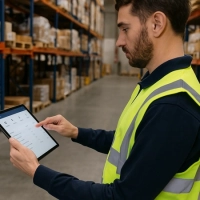
As a business begins to grow, it becomes increasingly difficult to keep track of things.
When processes like purchasing, inventory management, production, sales, and accounting are run on different systems, communication gaps occur. Invoices are delayed, inventory is mixed up, and reports are inaccurate. At this point, the solution businesses need is ERP systems that integrate all processes into a single platform.
ERP (Enterprise Resource Planning) software brings together companies' operations in a digital environment. The right ERP software allows you to use time more efficiently, reduce errors, and plan for growth. However, the first question on many businesses' minds is the same:
“How much does ERP software cost?”
It's impossible to answer this question with a single figure. ERP costs vary depending on the needs of each business. Many factors, including the number of users, the type of system, the number of modules, customizations, and support services, influence this cost.
In this article, we will examine the five most important factors affecting ERP costs in a simple and understandable way, using the FlatERP example.
1. Number of Users and License Model
The first factor that directly affects ERP costs is how many people will work in the system.
Each employee logs into the system with their own authorization. Stock managers, accountants, sales representatives, and managers use different areas. As the number of users increases, so does the system's license fee.
FlatERP offers a scalable structure in this regard.
Whether your business has 5 or 50 people, you can purchase a license for active users only. You can add or remove users as needed. This flexibility gives businesses the opportunity to grow without adding unnecessary costs.
There are also two primary differences between ERP licensing models: subscription and perpetual license.
As a cloud-based solution, FlatERP supports a subscription model. This allows you to use the software with monthly or annual payment plans without high initial costs. This model is particularly advantageous for SMEs.
2. Cloud ERP or Local Installation?
One of the biggest differences in the overall cost of ERP is where the software is hosted.
In cloud ERP systems, the software runs on remote, secure servers. Local installation (on-premises ERP) means installing the system on the company's own computers.
Since FlatERP is a completely cloud-based solution, it does not require hardware investment, server costs or maintenance expenses.
The installation process is quick, updates are automatic, and users can access the system from anywhere. This feature is particularly convenient for field teams and remote workers.
Local ERP systems typically have a higher initial investment cost. The company must install its own server, create a security system, and hire a technical team. This impacts both time and budget.
Therefore, cloud-based solutions like FlatERP offer a more flexible and cost-effective option for modern businesses. They ease the initial financial burden and accelerate the return on investment, especially for SMEs migrating to ERP for the first time.
3. Number of Modules and Functional Scope
Not every ERP system is the same.
While some businesses focus solely on accounting and inventory management, others use broader modules such as production planning, human resources, purchasing or project management.
FlatERP offers a modular structure at this point.
So, you can activate only the modules you want to use according to your needs.
For example, while a manufacturing company may activate the production planning module, project tracking and time management modules may be a priority for the service sector.
This approach directly impacts cost because each module requires a separate development, training, and support process.
The advantage of FlatERP is that it offers solutions only in areas that are useful to you, without unnecessary module load.
This way, the software remains simpler and the business only pays for what it needs.
The right ERP project doesn't try to cover every department to the same extent. Identifying prioritized processes and proceeding step-by-step allows you to manage costs more efficiently. FlatERP also provides consulting support to businesses in this regard, helping you determine which modules are best to start with.
4. Integrations and Customizations
One of the most important factors that increase costs in an ERP project is integration and customizations.
Every business uses different software, systems or devices.
Systems such as e-invoice, e-delivery note, e-archive, e-commerce sites or CRM applications must work in harmony with ERP.
FlatERP is fully integrated with the most widely used digital systems in Türkiye. It can connect directly with e-invoice, e-archive, e-delivery note, and accounting systems. This eliminates the risk of manual data transfer or errors.
However, some businesses may have specialized processes. For example, they may require special production recipes, different approval flows, or industry-specific reports. In these cases, the software needs to be customized. Customization is an investment that increases the cost of ERP but adds value to the business.
FlatERP's flexible infrastructure can quickly implement such custom developments.
Thanks to the modular structure of the system, it is possible to add new features or rearrange existing processes.
In other words, you direct the software, not the software directing you.
5. Support, Training and Maintenance Services
One of the most overlooked but most critical items in ERP projects is the cost of support and training .
An ERP system is not completed with just the installation; real efficiency is achieved when employees use the system correctly and actively.
FlatERP offers strong support to businesses in this regard.
During the installation process, expert teams guide users step by step.
Training support continues even after you start using the system.
This approach allows users to trade without errors and utilize the full potential of the system.
Additionally, the software world is constantly changing. Tax regulations, e-invoicing standards, and business processes are constantly updated.
FlatERP automatically applies all updates thanks to its cloud-based structure.
This way, users always have access to the latest version without any additional steps.
Support services make a big difference in the long term in terms of system sustainability.
Accessible technical support in case of problems directly affects user satisfaction and system efficiency.
Why is ERP Cost an Investment?
Many businesses only look at the price tag when evaluating an ERP system.
However, ERP is not a short-term expense, but a long-term investment.
A comprehensive system like FlatERP centralizes the operations of the business.
It reduces manual errors, speeds up reporting, prevents waste of resources and strengthens communication between departments.
This indirectly means saving both time and money.
The true return on investment in ERP is measured by how it transforms a company's processes.
An accounting department that operated manually a year ago can now produce accurate reports in minutes with ERP.
Stock management becomes automated, ordering processes are accelerated, and delivery times to the customer are shortened.
All of these are factors that increase profits.
Therefore, when evaluating the cost of ERP, it is necessary to look not only at the initial investment amount but also at the efficiency increase it brings in the long term.
To achieve this balance, FlatERP offers businesses a sustainable solution with its user-friendly interface, scalable structure and affordable licensing model.
Conclusion
ERP costs vary depending on the number of users, system type, module scope, integration needs and support services.
However, with proper planning and choosing the right solution partner, the return on this investment will be very fast.
Taking all these factors into account, FlatERP offers businesses a flexible, secure and scalable ERP solution.
It keeps costs under control with pricing options suitable for companies of all sizes, from small businesses to large corporations.
Thanks to its cloud-based structure, it reduces the initial investment burden and remains constantly updated.
In conclusion, ERP cost is not an expense but an investment in the future of the business.
FlatERP is designed to maximize this investment – because an efficient ERP system is not only profitable today, but also tomorrow.
























